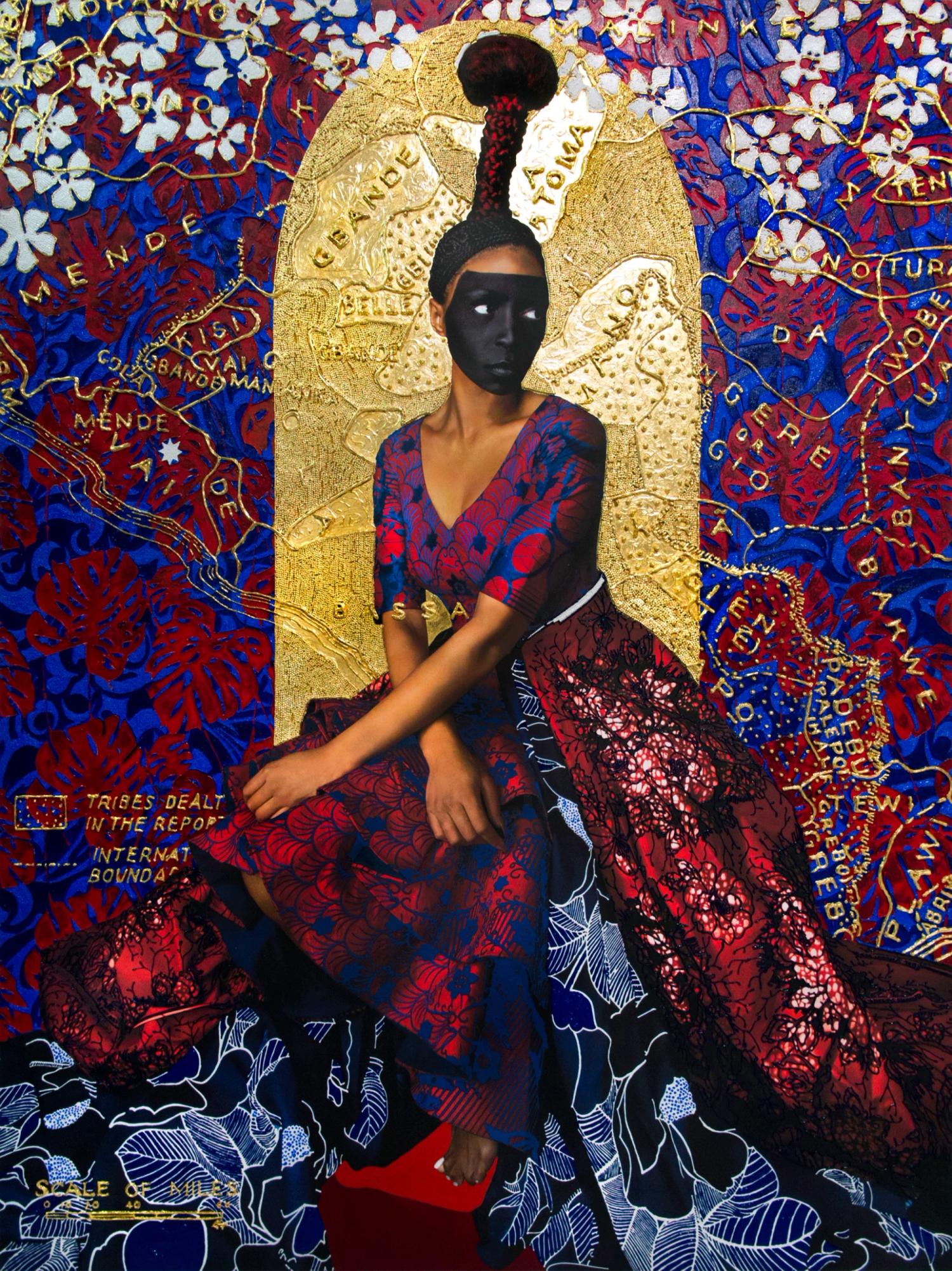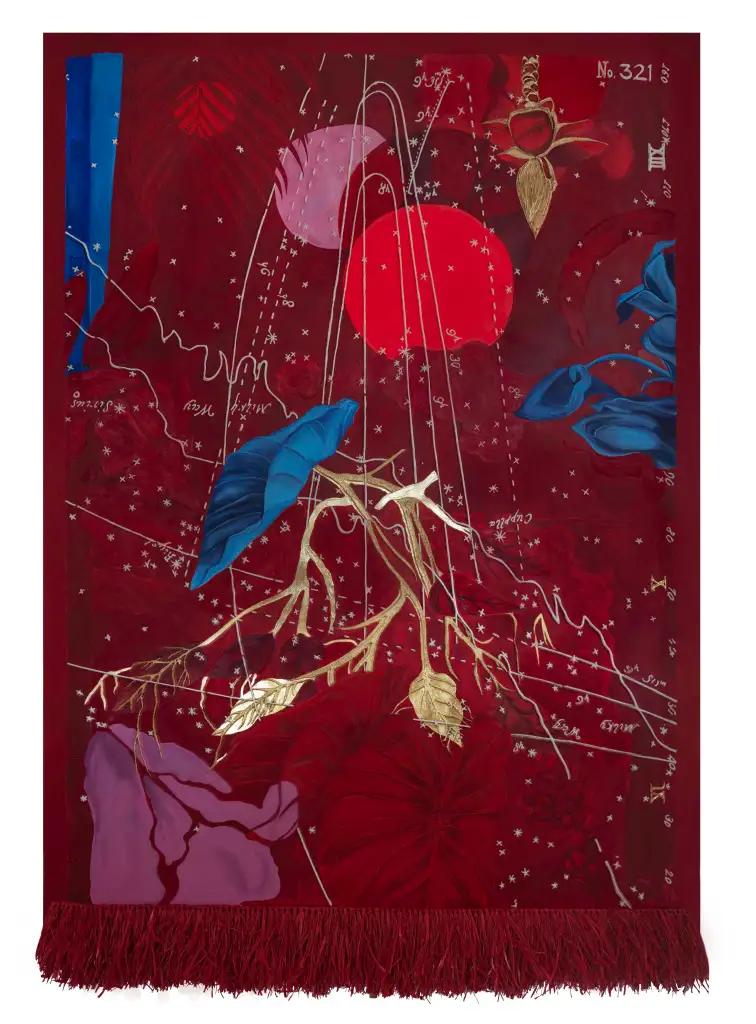Mapping Identities

Flying into Dublin last weekend, I looked out of the window over green and gold quilted fields and found myself wondering what English invaders thought when they came to colonise other lands. Did they desire to really know the land? To understand those who had lived and died, laughed and toiled on the earth they trod? Did they wonder how they could possibly know this land when there was so much they didn’t understand about what they had left behind?
I was recently talking to artist Lina Iris Viktor about her interest in maps. She spoke about a nineteenth-century map that she had incorporated into her series A Haven. A Hell. A Dream Deferred., which we are displaying as part of the exhibition In the Black Fantastic at the Hayward Gallery. The map documented the different ethnic groups living in the area of West Africa which would later be carved into Liberia by the American Colonization Society. Looking at Lina’s work, it struck me how, in many cases, map-making is an assertion of power. Maps of land often feel that way, carving up continents with solid impassable lines, trying to create clear delineation between geographies, peoples and cultures.
On a neighbouring wall, a newer work by Lina also featured a map but this time of the sky, of space. Rather than an assertion of power, to me this celestial map felt more exploratory. But still – this desire to explore, to know, to document is intimately connected to the need to categorise and control. After all, past ‘explorers’ from Western Europe often first set out with the apparently benign mission to document before this later became a mandate to subdue, control and conquer. Is the need to categorise a Western colonialist impulse?
In Octavia Butler’s science fiction novel Parable of the Sower, the main character Lauren writes about her need to name the religion she believes in: ‘sometimes naming a thing – giving it a name or discovering its name – helps one to begin to understand it. Knowing the name of a thing and knowing what that thing is for gives me even more of a handle on it.’ I think perhaps we have a fixation on knowing the names for things with the false belief that this leads to us understanding them, and we too rarely think about the second part of Lauren’s reflection: ‘knowing what a thing is for’, or perhaps even ‘knowing what naming is for’.
Not too long ago, a colleague and I were asked to work out the racial diversity of an international art collection. For us, it proved an impossible task: to devise categories and ascribe individual artists to them when the world and its inhabitants are not only so diverse, but so intermixed. The categories that we use in the UK census, for example, are already contested. How on earth could we categorise the people of an entire planet? And to what end? The dividing of people into categories felt distinctly colonial. And was mapping an art collection into these bordered states another assertion of power?

Demarcating people into different racial categories is fraught with problems and heavy with historical significance. Author Emma Dabiri recently posted on Instagram about why she doesn’t use the term ‘mixed-race’. To her, blackness, unlike whiteness, is not about purity. It is expansive, generous, a map with blurred boundaries, and therefore the phrase ‘black and mixed-race black’ is redundant.
When I first read her post I was upset and annoyed. As someone who grew up thinking of myself as mixed-race (but who most people would identify as black), I felt like I was being told not only what I was allowed to call myself, but who I was allowed to be. But I was also intrigued: was my reaction because I liked the idea of belonging to a category which feels fairly fluid when a lot of the time I don’t feel like I fit in with what society tells me about blackness or whiteness? Did I see ‘mixed-race’ as a categorisation, but one that nevertheless stood outside or beyond the (seemingly distinct) categories of black and white? On reflection, Emma’s argument made me realise that maybe I need to do away with this sense of categorisation that mixed-race also inevitably subscribes to.
The idea of racial purity makes me think about monoculture farming, like in the California almond farms I saw in David Attenborough’s Green Planet. On these farms, there is no other wildlife apart from the almond trees. No grass, no flowers, no other species. They even have to import bees during pollination season because the habitat won’t support bees and other pollinators year round. The plants are not part of a wider ecology. Just humans asserting power over nature and, by drawing up harsh borders, creating the conditions of our own demise. The more I thought about it, the more the idea of being mixed-race meant believing in ‘monoculture races’, barriered off from any outside interference.
To understand something we often compare it to what we know, which really is a way of categorising – how is it similar, how is it different. For such a long time, categorisation felt to me like a way of making sense of the world. But maybe instead of carving people and the world up into the interlocking sections of a map, we can picture our world as layered ideas, ecosystems and identities, one on top of the other. Permeating each other. Reliant on each other. Unable to see one without seeing all. Maybe we need to think about a different kind of knowledge that comes from experiencing something new without assuming we know the things we consider familiar.
As Lauren writes in Parable of the Sower:
‘Earthseed
Cast on new ground
Must first perceive
That it knows nothing.’
